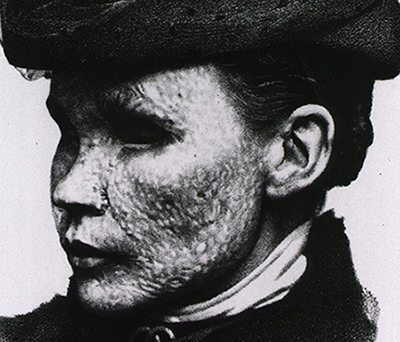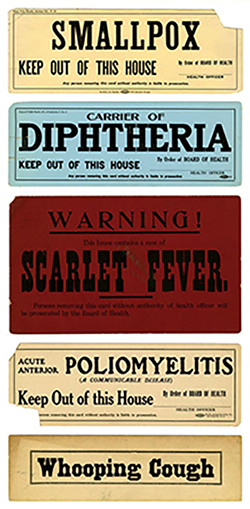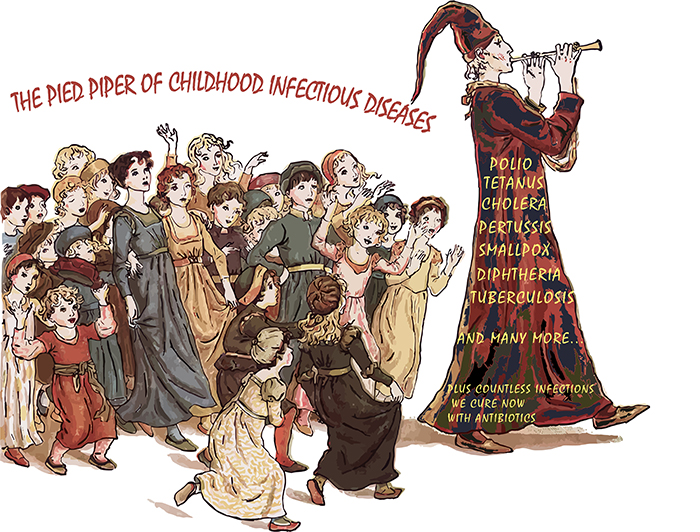A Nightmare Plague or Business as Usual?
"Imagine a world where half the children never grow up..."
How It Always Was
Imagine a world where almost half of all children die before age 15, and 1 in 4 infants die in their first year? Yup, you read that right, 5 out of every 10 children dead before age 15. Does that sound like a nightmare plague, a death scenario worse than the Black Death? The end of times?
Nah, that’s just how this world always was for most of the previous 2400 years, and certainly long, long before. Always, relentlessly, no exceptions, rich or poor, kings or paupers, saints and sinners, all races, creeds, and nations. It’s an average, of course, some places at some times were better and some places at some times were worse – far worse. (See the link at page bottom for a good reference explaining these numbers).
I’m talking about common, plain, ol' fashioned infectious diseases, and the “good ol’ days” when children relied only on their immune systems (which some people now tell us is enough). No amount of money or power could save your child from these relentless diseases.

Credit: A plague hospital; 16th century German engraving by Jeremiah Wolff; NY Public Library.
Smallpox is generally considered the biggest killer of all time (though I know of at least one medical historian who claims that honor goes to tuberculosis). Like most, smallpox was an egalitarian disease. Saints and sinners, the children of kings and the children of peasants, were all treated equally by smallpox. The death rate for those infected was around 30%, though for children, it was sometimes much higher.
Smallpox was a painful, miserable way to die. There are acounts of badly scarred survivors wearing masks the rest of their lives. It was also a common cause of blindness. In the eighteenth century smallpox killed an estimated 400,000 Europeans each year, one in every 7 Russian children born, and five reigning European monarchs. In the twentieth century, an estimated 300 to 500 million died worldwide. That’s more than World Wars I and II, and all the other wars of the twentieth century, combined.

Credit: National Library of Medicine, National Institute of Health.
Now, wonder of wonders, smallpox is gone from everywhere.
How Could We Forget?
In the good ol’ days people didn’t have to be taught the history of child-killing infectious diseases. They lived with it.
Astonishingly, to me, many people nowadays seem to not know this.
The Dream
I had a dream the other day.
In the dream I went back to the year 1800 and met a young couple expecting their first child. They, like all other parents then, understood that their child had a high probability of not reaching adulthood. Like the flip of coin, but with much graver consequences than deciding who gets to go first.

Credit: National Library of Medicine, National Institure of Health
There was a good probability they would have more than one child, and a high probability they would watch one or more suffer and die from one of the many infectious diseases always waiting to strike. It might be diphtheria, or it could be slowly and miserably from tuberculosis (the second biggest killer of everyone in 1900). Or perhaps the child would get rheumatic fever, mumps, tetanus, whooping cough, pneumococcal disease, typhus, polio, or influenza and pneumonia (there were no antibiotics against bacterial pneumonia), smallpox, and many others. Or it might just be a small scratch that, without antibiotics, would result in a deadly infection.
I told the expecting parents that in the 21st century much less than 1 child in a hundred would die before age 20, at least in the so-called developed nations. They cried with the wonder of it and asked how this miracle had come to be.
I told them about the various microbiotic pathogens we collectiverly call "germs". Few believed in them in 1800 (many doctors believed cholera was caused by some type of vapor or "miasma"). I told them about vaccination, antibiotics, chlorinated water, pasteurized milk, and modern sanitation methods. I told them that in the 21st century many people took this miracle for granted. It was all they’d ever known. They were ignorant of the past and seemed not to know about all the infectious diseases that killed so many children. Unlike smallpox, most of the pathogens for those deadly diseases are still around. Many people motivated by irrational fear, misinformation, and poor understanding of comparitive risks, are against vaccination, chlorinated water, and pasteurized milk. And I told them we were seeing the emergence of dangerous antibiotic resistant bacteria, yet we continued to pump antibiotics needlessly into livestock.
They laughed in disbelief. The man said, "But how could this be? We would tar and feather such fools.
The woman said, “Take us to the future for the sake of our child, and we'll tell them. We’ll tell them how the children died. We’ll tell them what it is like in our time. I will tell them about listening to my little brother suffocate with diphtheria. I'll tell about my older sister suffering for years with tuberculosis, coughing blood, becoming so emaciated, then finally dying. I will show them my smallpox scarred face.”
Then I woke up. I was sad that I couldn’t bring them with me. Would their story have helped I wondered? What does it take to change beliefs that are not based on verifiable facts, data, and reason? Apparantly not data and reason. People have an amazing ability to see only what they want, or believe they need, to see. But maybe a little knowledge of history, of the real “good ol’ days”, and the deadly germs that are still all around us, everywhere, will at least help us to keep our minds a little more open.
How They Did It - A Series on How to Reduce Childhood Mortality
This page is the introduction to a coming series, in this website, on the cheery subject of childhood mortality. I'm only partly kidding about it being cheery, because for the past hundred or so years, the story, in the more developed nations, has gotten cheerier and cheerier. Hopefully the series will help motivate us to not only keep it that way, but continue to make it better, for all children.
The coming articles will describe some of the major diseases that killed so many children and the most significant interventions that reduced average childhood death rates from half of every child born, to much less than 1 in a 100. It seems like a miracle. But it’s not. It was brought about by the knowledge gained by scientists applying the scientific method. Yet it was not accomplished by scientists alone.
The implimentation of disease preventing scientific knowledge into life saving changes in the US and other countries, required much more than scientists. It required the unfailing persistence of activists, courageous progressive journalists, enlightened determined politicians and the persistent government programs they provided. It also required the unselfish commitment and support of millions of citizens. As we will see, there were people who fought against almost every life-saving intervention.
Coming Soon: Small Pox: The Biggest Killer
In the meantime:
Read an amazing story of human growth
and the scientic method: What the Dinosaurs Never Knew
The link below will take you to a great source for more data on past childhood mortality rates. Be sure to scroll down a little and click to view the amazing graph. Note the steep fall off in death rates over that last 120 years or so:



